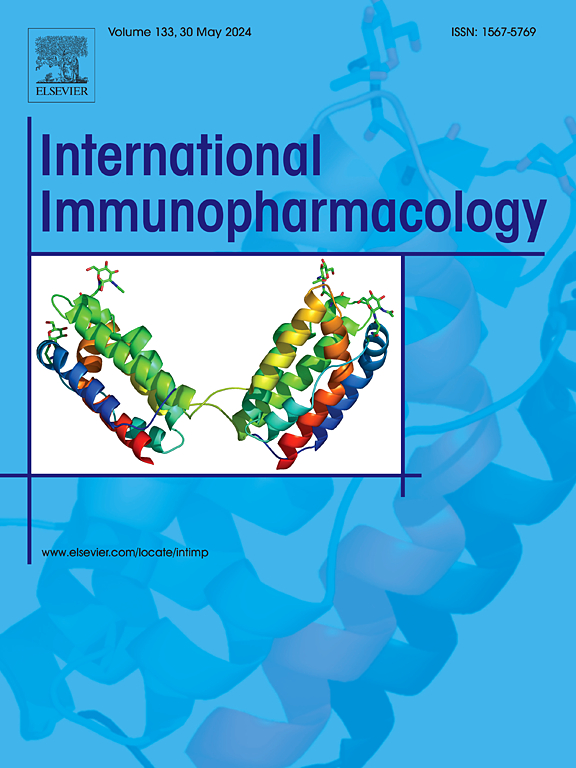CREG1 attenuates intervertebral disc degeneration by alleviating nucleus pulposus cell pyroptosis via the PINK1/Parkin-related mitophagy pathway
IF 4.8
2区 医学
Q2 IMMUNOLOGY
引用次数: 0
Abstract
Intervertebral disc degeneration (IVDD) is a chronic degenerative disease with a complex pathophysiological mechanism. Increasing evidence suggests that the NOD-like receptor thermal protein domain associated protein 3 (NLRP3)-mediated pyroptosis of nucleus pulposus cells (NPCs) plays a crucial role in the pathological progression of IVDD. Pyroptosis is a novel form of programmed cell death characterized by the formation of plasma membrane pores by gasdermin family proteins, leading to cell swelling, membrane rupture, and the release of inflammatory cytokines, which trigger an inflammatory response. The close relationship between pyroptosis and mitophagy has been previously described in various diseases, but the crosstalk between pyroptosis and mitophagy in IVDD remains unexplored. Cellular repressor of E1A-stimulated genes 1 (CREG1) is a secreted glycoprotein involved in cell differentiation and homeostasis regulation and has been shown to promote lysosomal biogenesis and function. However, the potential role and underlying mechanisms of CREG1 in the progression of IVDD have not yet been reported. In this study, we first observed that CREG1 is downregulated following IVDD and that pyroptosis occurs. Furthermore, CREG1 knockdown inhibited NPC proliferation and exacerbated apoptosis and degeneration. Moreover, we confirmed that CREG1 knockdown induced NLRP3 activation while also leading to mitophagy inhibition and mitochondrial dysfunction in NPCs. CREG1 overexpression ameliorated LPS-induced mitophagy inhibition and mitochondrial dysfunction by promoting PINK1/Parkin-mediated mitophagy, thereby suppressing NLRP3 inflammasome activation. However, these protective effects were reversed by pretreatment with the mitophagy inhibitor cyclosporin A (CsA). In a rat model of IVDD, imaging and histological assessments revealed that CREG1 overexpression effectively alleviated the progression of IVDD. Additionally, CREG1 overexpression reduced the expression of NLRP3, caspase-1, and IL-1β while increasing the expression of collagen II, PINK1 and LC3, delaying the course of IVDD. Overall, this study highlights the importance of the interplay between CREG1-mediated regulation of mitophagy and pyroptosis in the pathogenesis of IVDD, identifying CREG1 as a promising therapeutic target for IVDD treatment.

CREG1通过PINK1/帕金森相关的有丝分裂途径减轻髓核细胞焦亡,从而减轻椎间盘退变。
椎间盘变性(IVDD)是一种病理生理机制复杂的慢性退行性疾病。越来越多的证据表明,NOD样受体热蛋白结构域相关蛋白3(NLRP3)介导的髓核细胞(NPC)热噬在椎间盘退行性变的病理进展中起着至关重要的作用。髓核细胞热解是一种新型的程序性细胞死亡,其特点是由气体蛋白家族蛋白形成质膜孔,导致细胞肿胀、膜破裂和释放炎性细胞因子,从而引发炎症反应。以前曾在多种疾病中描述过热蛋白沉积和有丝分裂之间的密切关系,但在 IVDD 中热蛋白沉积和有丝分裂之间的相互影响仍未得到探讨。E1A 刺激基因的细胞抑制因子 1(CREG1)是一种分泌性糖蛋白,参与细胞分化和稳态调节,并被证明能促进溶酶体的生物生成和功能。然而,CREG1在IVDD进展中的潜在作用和内在机制尚未见报道。在本研究中,我们首次观察到 CREG1 在 IVDD 发生后下调,并发生热蛋白沉积。此外,CREG1基因敲除抑制了NPC的增殖,加剧了凋亡和变性。此外,我们还证实,CREG1 基因敲除在诱导 NLRP3 激活的同时,还导致 NPC 的有丝分裂抑制和线粒体功能障碍。通过促进 PINK1/Parkin 介导的有丝分裂,从而抑制 NLRP3 炎性体的激活,CREG1 的过表达改善了 LPS 诱导的有丝分裂抑制和线粒体功能障碍。然而,丝裂吞噬抑制剂环孢素 A(CsA)的预处理逆转了这些保护作用。在 IVDD 大鼠模型中,成像和组织学评估显示,CREG1 的过表达能有效缓解 IVDD 的进展。此外,CREG1的过表达减少了NLRP3、caspase-1和IL-1β的表达,同时增加了胶原蛋白II、PINK1和LC3的表达,从而延缓了IVDD的进程。总之,这项研究强调了CREG1介导的有丝分裂和细胞增殖之间的相互作用在IVDD发病机制中的重要性,并将CREG1确定为治疗IVDD的一个有前景的治疗靶点。
本文章由计算机程序翻译,如有差异,请以英文原文为准。
求助全文
约1分钟内获得全文
求助全文
来源期刊
CiteScore
8.40
自引率
3.60%
发文量
935
审稿时长
53 days
期刊介绍:
International Immunopharmacology is the primary vehicle for the publication of original research papers pertinent to the overlapping areas of immunology, pharmacology, cytokine biology, immunotherapy, immunopathology and immunotoxicology. Review articles that encompass these subjects are also welcome.
The subject material appropriate for submission includes:
• Clinical studies employing immunotherapy of any type including the use of: bacterial and chemical agents; thymic hormones, interferon, lymphokines, etc., in transplantation and diseases such as cancer, immunodeficiency, chronic infection and allergic, inflammatory or autoimmune disorders.
• Studies on the mechanisms of action of these agents for specific parameters of immune competence as well as the overall clinical state.
• Pre-clinical animal studies and in vitro studies on mechanisms of action with immunopotentiators, immunomodulators, immunoadjuvants and other pharmacological agents active on cells participating in immune or allergic responses.
• Pharmacological compounds, microbial products and toxicological agents that affect the lymphoid system, and their mechanisms of action.
• Agents that activate genes or modify transcription and translation within the immune response.
• Substances activated, generated, or released through immunologic or related pathways that are pharmacologically active.
• Production, function and regulation of cytokines and their receptors.
• Classical pharmacological studies on the effects of chemokines and bioactive factors released during immunological reactions.
文献相关原料
公司名称
产品信息
索莱宝
Hematoxylin and eosin (HE)
阿拉丁
adenosine triphosphate (ATP)

 求助内容:
求助内容: 应助结果提醒方式:
应助结果提醒方式:


